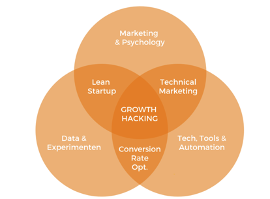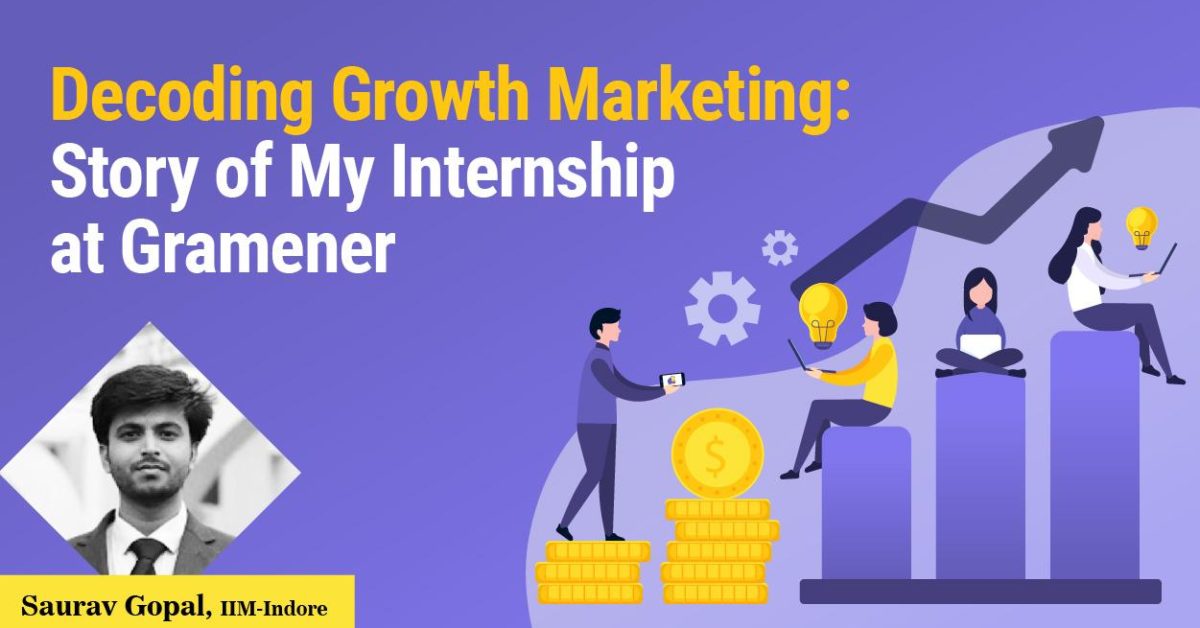This article is written by Saurav Gopal from IIM – Indore. In this article, Saurav shares his experience and learning about growth marketing during his internship stint at Gramener.
Table of Contents
What is Growth Marketing?
Growth marketing is a scientific marketing approach to grow any key metric, such as lead generation or brand awareness. It is a process of rapid experimentation across marketing channels and product development.
Growth marketing helps us identify the most efficient ways to grow a business by designing and conducting experiments to optimize and improve the target area’s results.
As the name suggests, growth marketing teams grow a target area of business. They do this by:
● Finding areas and tactics to test and improve
● Developing and designing data experiments to optimize the identified processes with clear success criteria
● Conducting these experiments to test their hypothesis
● Analyzing results and scaling up what’s working to grow the given metric
How is it Different From Marketing and Growth Hacking?
Within most organizations, growth teams work closely with the marketing team either as a subunit or a separate function itself. The collaboration enables an analytically minded function that focuses more on the data side of marketing than the creative aspect.
The diagram below gives a better understanding.

Growth hacking and growth marketing are the same. Since hacking has a negative connotation, some firms choose to call it growth marketing.
The Framework of Growth Marketing
Let’s take a simple example to explain the process of growth marketing. An OTT platform wants to increase its subscriber base. Let’s set up a growth team for the same.
The subscriber count is usually the North Star metric for OTT platforms. So let’s see how this can be scaled up.

Step 1: Desk research
We sketch a tree-like model to understand all the aspects that influence the subscriber count. We, then, look at what your competitors are doing in each of these areas. For instance, what are the best practices or tactics used across the industry?
After getting the hang of a few tactics, the next step is to design experiments to validate that these tactics will provide results when done at scale.
Step 2: Experiment Design
So, how do you convert a tactic into an experiment? An actual experiment follows the scientific method. It begins with a clear hypothesis that makes predictions about what is supposed to happen. It then tests those predictions empirically.
Let’s say you are thinking of running a Facebook campaign to retarget the users who came to your website and offer a free trial. You try to upsell and convert them into subscribers. You have to convert this tactic into a growth experiment or pilot test with clear success criteria and minimal resources.
For instance, run a $1,000 pilot test for a week or so and then see what the X%, Y%, and Cost per Customer are. This will give us the estimated cost to reach the target subscriber count.

Step 3: Prioritizing
Now, you have a batch of experiments ready to be tested, but how do you prioritize which one goes first? A popular method is the ICE method, which stands for Impact, Confidence, Ease. In this method, you rank each experiment based on its expected impact on the North Star metric, the confidence you have on this tactic, and ease of execution.

The ones with the highest scores go first.
Step 4: Execution
This is when you need to ensure that you meet all the requirements to execute the perfect pilot test to give you data-backed results.
In the case of Facebook ads, it would mean using the same creative and copy and landing page, which you would use if it’s scaled up (but keeping an eye on the budget as well).
Step 5: Analyzing the results
After you have executed the experiment and have some numbers, you can check whether your success criteria have been met. If it has, the question that needs to be answered is, what would be the cost and impact if you scale this?
Based on the answer, you need to either kill, pivot, or scale the experiment.
In the Facebook ads scenario, if you see that you could achieve the same result with a different copy/creative/landing page or funnel itself, then pivot it. If it hasn’t delivered as expected, then kill it. It was a learning experience, and you now know what to avoid. On the other hand, if it succeeded, you can scale it to reach a wider audience.
My Growth Marketing Internship Experience at Gramener
I recently finished my internship with Gramener in the Growth Marketing Profile. It was thrilling to take on the first growth project, that too, in a data science company. Backed by my mentors, I managed to level up from desk research to the experimentation phase quickly, but for me, the most challenging part was the execution.
For example, one of our tests was to on-board chatbot subscribers through Facebook ads. For this, I had to learn how to build a chatbot and run a messenger campaign overnight on Facebook. This is the kind of thrill and learning that I had always wanted.
Within the short duration of the internship, we got some quick wins and failures, and I got an authentic feel of what is to like to drive growth with data-backed experiments.
My key learning from the internship was how to keep questioning your point of view. Every time I had a meeting with the team to talk about a pilot test I wanted to run, they kept asking me, “What is the hypothesis?” and it was with time I realized how to build a strong hypothesis with which you can test your assertions and assumptions.
Final Thoughts
If you have read the book Lean Start-up, you would be quite familiar with the lean way of determining how businesses works. This is exactly what growth marketers and product managers use to determine what works for them.
The basic idea is to test your assertion with a pilot test and then decide to kill, scale, or pivot instead of the traditional way of just scaling up what you think will work best. Companies like Dropbox, Airbnb, Paypal, and Hubspot have successful growth marketing stories.
